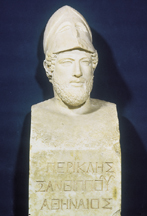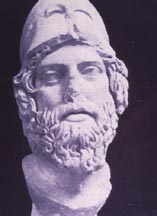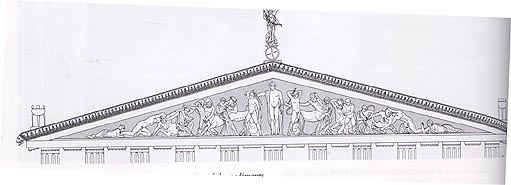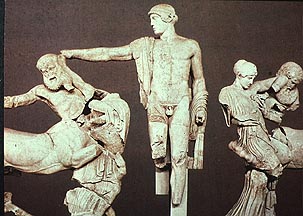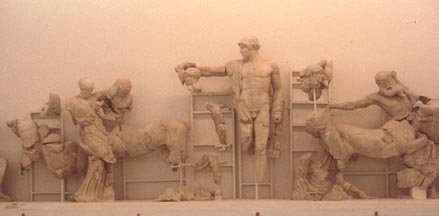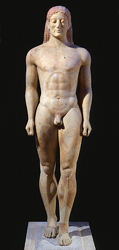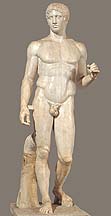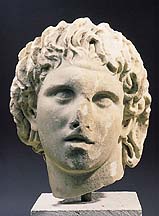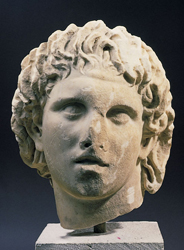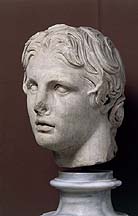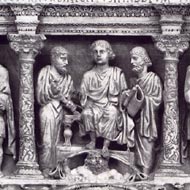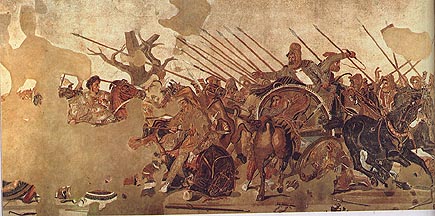ARTH Courses | ARTH 200 Assignments
Images of Authority II: The Greek Example
A striking feature of early Greek art is the relative absence of ruler images. This presents a stark contrast to the role ruler images played in Egyptian and Ancient Near Eastern Cultures. The work above at first seems to be a possible exception. This is a Roman copy of a bronze statue of the Athenian political leader Pericles, who was the great Athenian political leader of the middle of the 5th century BCE. This was the period of Athenian supremacy. It was under Pericles that Athens engaged in a great building campaign that included the major buildings on the Acropolis. We will discuss later in the semester the Parthenon, the centerpiece of this campaign. Pericles served in the position of strategos or military commander. The Athenians attempted to avoid the concentration of power in the hands of a single ruler or tyrant by forbidding leaders of higher offices to succeed themselves. It was only the military commanders that could hold office multiple times. Pericles was able to manipulate his position as strategos into becoming the de facto ruler of Athens.
The original statue of Pericles was probably done shortly after Pericles' death in 429 BCE and was created by the sculptor Kresilas. The inscription which reads "Pericles, son of Xanthippos, the Athenian" leaves little question of the identification. From our cultural perspective we would expect the portrait to have been individualized, but as demonstrated by the following examples, the strategos portrait was a defined type in Greek art:
The differences between these "portraits" say less about the differences between the different individuals represented than they reflect the different stages in the development of Greek art. The one from c. 500-470 BCE still has strong traces of the Archaic style of the 6th and early 5th centuries, while the one from c. 430-400 BCE has the characteristics of the High Classical style of the middle of the 5th century. Characteristics of the strategos type include the helmet of a military commander and the beard. The latter says more about the venerable nature of the strategos. In considering the Pericles "portrait" we need to seriously qualify our assumptions about a portrait. As a truism of Greek culture, the Greeks did not emphasize what distinguishes one individual from another, but how the individual conformed to the common type. In other words they saw the particular from the perspective of the archetypal. So it is less Pericles' distinctness and more of how he conforms to the ideal or expectations of what a strategos should be. The Roman writer Pliny in describing the Kresilas "portrait" characterized it as "the Olympian Pericles," or in other words how Pericles reflects the Greek conception of their gods.
Protagoras of Abdera (c. 480-410 BCE), a Sophist philosopher, coined the famous dictum that "man is the measure of all things." A common theme of Sophist philosophy of the 5th century BCE was that man's subjective experience is the foundation of human thought including conceptions about the nature of existence, of ethics, and of knowledge. Greek classical culture was essentially anthropocentric or centered on man in marked contrast to theocentric cultures. In Classical art the distinction between the God and mortal man is blurred. This can be exemplified by an examination of the sculpture in the pediment over the western entrance of the Temple of Zeus at Olympia
The pediment
represents the legendary conflict between the Lapiths and Centaurs. The centaurs
were a fabulous race of half human and half horse creatures from untamed regions
of Thessaly. They were invited to attend the wedding of the king of their
neighbors, the Lapiths. In the midst of the wedding the centaurs became drunk
and disorderly and attempted to abduct Hippodamia, the bride of Peirthoös.
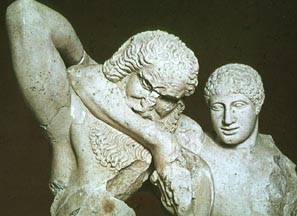 In
the ensuing battle the Lapiths overcome the centaurs. The centaurs as both
being half human and being in a state of drunkenness are clearly set off from
the Lapiths. The wild ferocity of the centaur is here contrasted to the restrained
expression of the Lapith. Clearly the Lapiths are like the stern and aloof
figure of Apollo who towers over the center of the composition. The popularity
of this subject matter in Greek Archaic and Classical art can be explained
by its theme of order or cosmos overcoming chaos and a series of related binaries:
reason and self-control overcoming immoderate passion, culture overcoming
nature, civilization overcoming barbarism, human techné (technology)
harnessing wild, animal forces of nature, and Greek defeating non-Greek. This
contrast between the Greek and the non-Greek is further developed in the webpage
entitled The Greek and the Other.
In
the ensuing battle the Lapiths overcome the centaurs. The centaurs as both
being half human and being in a state of drunkenness are clearly set off from
the Lapiths. The wild ferocity of the centaur is here contrasted to the restrained
expression of the Lapith. Clearly the Lapiths are like the stern and aloof
figure of Apollo who towers over the center of the composition. The popularity
of this subject matter in Greek Archaic and Classical art can be explained
by its theme of order or cosmos overcoming chaos and a series of related binaries:
reason and self-control overcoming immoderate passion, culture overcoming
nature, civilization overcoming barbarism, human techné (technology)
harnessing wild, animal forces of nature, and Greek defeating non-Greek. This
contrast between the Greek and the non-Greek is further developed in the webpage
entitled The Greek and the Other.
The standing nude male figure dominates Greek art of the Classical figure. One of the most famous of these statues was the Doryphoros by Polykleitos. The statue is no longer extant but it is well known through ancient descriptions along with later Roman copies.
The dominant subject matter in Greek free-standing sculpture of the Archaic (extending from the end of the seventh century BCE to the early fifth century BCE) and Classical periods was the nude male. While not made for explicit political purposes, these statue do still convey the cultural and political ideal for this culture. These are a clear testament to the anthropocentric nature of Greek culture. There is little to distinguish the representations between divine and mortal inthese statues. Scholars have long debated about the identity of the Archaic kouros figures, or standing nude male figures. Early scholars saw these figures as images of the god Apollo, while subsequent archaeological discoveries have revealed names associated with some of these statues. For example, the base of a kouros from the third quarter of the sixth century BCE from Anavysos bears an inscription that identifies the figure as Kroisos.
Like we saw in our discussion of the Pericles portrait above, we need to qualify our assumption that this is a representation of the individual likeness of Kroisos. Rather than focusing on what distinguishes Kroisos from other males, the work displays how is like or typical of the ideal male, whether mortal or immortal.
A major work from the middle of the fifth century BCE or the Classical period is the so-called Doryphoros by Polykleitos. Like the kouroi figures this statue is not a representation of a particular individual but again a representation of an ideal figure. Ancient references and modern studies have emphasized how Polykleitos intended this figure as a demonstration of his conception of kallos or the beautiful. He saw in the proportions of this figure a reflection or "measure" of the cosmos. Review the webpage I have dedicated to the Doryphoros.
Portraits of Alexander the Great: The later history of Greece is dominated by the rise of the kingdom of Macedon and the conquests of Alexander the Great. Under Alexander's father, Philip II, Macedon was able to subdue the other Greek city-states. After Philip's assassination in 336, Alexander was able to carry out a remarkable series of military conquests. By the time of Alexander's death in 323 BCE, Macedonian hegemony extended over Egypt, the Persian Empire, and extended to India. While the Empire was quickly politically fragmented with its subdivision among the followers of Alexander, the lands conquered by Alexander were culturally unified by the spread of Greek or Hellenic culture. including its religion, philosophy, literature, art, and architecture. This cultural unity would be a critical key to the later success of the Romans in establishing their Empire.
Alexander, undoubtedly influenced by the ruler portraits of the Ancient Near East and Egypt, was aware of the political importance of his image both in life and in his portraits. In life he fashioned himself on Achilles the epic hero of Homer's Iliad. At the same time he was aware of the effective role pictorial representations of himself could play in establishing his poltical rule over the domains he conquered. Alexander appointed Lysippos as his court sculptor. Only Lysippos was allowed to sculpt Alexander's image. Ancient sources describe a full length, heroically nude bronze portrait of Alexander holding a lance and looking to the heavens. Plutarch calls attention to the "leonine" or lion-like mane of Alexander's hair and his "melting glance." Plutarch records an inscription on the base which proclaimed, "I [Alexander] place the earth under my sway; you, O Zeus, keep Olympus."Thus the order of Zeus over Olympus is paralleled to the order of Alexander over his Empire.
The original bronze made by Lysippos has been lost, but there are still extant a relatively large number of portraits of Alexander that are undoubtedly based on the Lysippos original:
The three Alexander portraits illustrated above share the dramatic locks of hair, turning neck, and the animated gaze directed to the heavens described by Plutarch as a characteristic of the Lysippos original. All of the portraits of Alexander show him as beardless. This was a deliberate choice on the part of Alexander, and marked a break in the custom of political leaders wearing beards. We have already seen how in the strategos portrait of Pericles the beard was an integral part of the formula. Alexander's own father was consistently shown with a beard. The appearance of the beard was intended to convey the wisdom and venerable nature of the ruler. In contrast to that Alexander adopted the more youthful, beardless type. In so doing, Alexander was likening himself to the heroes of Greek epics like Achilles or the youthful god Apollo. The choice of wearing a beard or not will be an important factor in later ruler images. For example, it was deliberate on the part of the Emperor Augustus of Rome to have his portraits convention to be youthful and beardless while the later philosopher Emperor Marcus Aurelius will be represented with a beard to conform to the philosopher type. It is not by chance that the early period of Christian art shows competing conventions for representing Christ. In some cases you see him as being a beardless Apollo type as in the middle of the 4th century sarcophagus of Junius Bassus, while in other cases, like the mosaic from Santa Pudenziana from the end of the 4th century, he is represented with a beard that makes him like Zeus or Jupiter.
In the portrait of Pericles discussed above, the emphasis was primarily on how Pericles conformed to the role of strategos rather than his individual identity or personality, but here in the portraits of Alexander, there is more of an emphasis on the heroic personality. The effect of the presence of Alexander's personality in these portraits is suggested by an anecdote included in Plutarch's biography of Alexander. Cassander, one time rival and successor as king of Macedon of Alexander, some years after the death of Alexander encountered the latter's portrait in a sanctuary in Delphi. At the sight of the statue,Cassander was struck "with a shuddering and trembling of the body from which he barely recovered, and caused a dizziness which blurred his vision." The relationship between Alexander and Lysippos as court sculptor establishes an alliance between politics and art that will be extremely influential in later Ancient and European history. Images of the king spread throughout his territory give physical testimony to his hegemony and become forceful expressions of his personality. The artist thus becomes an image maker like a modern PR-man attempting to fashion a public identity for a modern politician.
A floor mosaic
found in the remains of a Roman house in Pompeii is likely a copy of a panel
painting peainted by Philoxenos of Eretria about 310 BCE. The mosaic represents
the pivotal moment in the Battle of Issus when the Persian king Darius retreats
from the relentless attack of the Greeks led by Alexander on horseback. 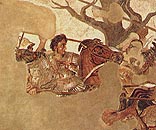
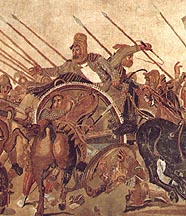 The
narrative focuses on the contrast between the heroic Alexander personally
leading the attack and the fearful Darius. Alexander was known to have had
a horse named Bucephalus who was so wild only Alexander could tame and ride
him. In a later context, we will relate this image to the importance of the
horse in western culture with special emphasis on the equestrian figure.
The
narrative focuses on the contrast between the heroic Alexander personally
leading the attack and the fearful Darius. Alexander was known to have had
a horse named Bucephalus who was so wild only Alexander could tame and ride
him. In a later context, we will relate this image to the importance of the
horse in western culture with special emphasis on the equestrian figure.
To find images of authority and power in the early stages of Greek art we do not look at ruler images like we can see in Egyptian and ancient Near Eastern cultures but rather we look at representations of the Gods and of the type of the male figure.
